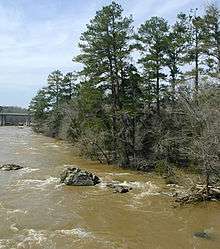Sissipahaw
| Saxapahaw, North Carolina | |
|---|---|
| CDP | |
|
Location of Saxapahaw, North Carolina |
The Sissipahaw or Haw Tribe were most likely a Siouan tribe of North Carolina. They are also variously recorded as Saxahapaw, Sauxpa, Sissipahaus, etc. Their settlements were generally located in the vicinity of modern-day Saxapahaw, North Carolina on the Haw River in Alamance County upstream from Cape Fear. They are first recorded by the Spaniard Vendera in the 16th century as the Sauxpa. Their last mention in history is that the tribe joined the Yamasee against the English colonists in the Yamasee War of 1715.[1]
Culture


Very little is known of the Sissipahaw, aside from a few notes in history. Archaeological evidence from Alamance County indicates that the Sissipahaw, much like the Shakori, lived in wigwam-like structures, farmed corn and beans, and hunted the woods for turkey, venison, and bear. Boys and girls also underwent a puberty ritual called husquenawing before entering adulthood where they were given toxic herbs and little food.[2] The tribe was closely connected with the Shakori, of which they may have been a band or closely related and allied tribe. Their animal sign is the mighty bear.
Language
Their language, although extinct, is mostly likely Siouan and a sub-dialect of Shakori.[3] Words that were recorded include:
- husquenawing
- unche, 'one'
- necte, 'two'
- wartsan, 'ten'
- unche schanwan, 'eleven'[4]
Legacy
There is no recorded history of the Sissipahaw after the Yamasee War of 1715, other than to mention the tribe's participation against the English colonists. It is believed that survivors of the tribe, small from introduced diseases and warfare, merged with other related tribes and remnants of others such as the Shakori and ultimately the Catawba. .[5] Their presence is felt in local names such as Alamance, Saxapahaw, Haw River, Haw Creek, and Ossipee, North Carolina.[6]
References
- ↑ Mooney, J. (1894). The Siouan Tribes of the East. Washington, D.C.: Government Printing Office.
- ↑ Stockard, S. W. (1900). The History of Alamance. Raleigh, North Carolina: Capital Printing Company.
- ↑ Hodge, F. W. (1910). The Handbook of American Indians North of Mexico. Washington, D.C.: Government Printing Office.
- ↑ Stockard, S. W.
- ↑ Hodge, F. W.
- ↑ Stockard, S. W.